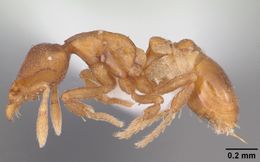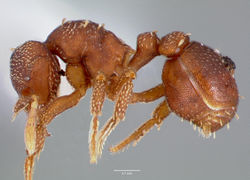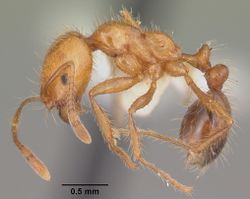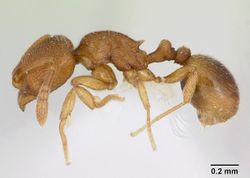Key to Hispaniola Genera of Myrmicinae
Additional information about the ants of the island can be found here: Ants of Hispaniola
1
- Antenna with 7 or fewer segments . . . . . 2
- Antenna with 10 or more segments . . . . . 3
2
return to couplet #1
- Antenna with 4 or 6 segments . . . . . Strumigenys of Hispaniola
- Antenna with 7 segments . . . . . Eurhopalothrix . . . one species present: Eurhopalothrix floridana
3
return to couplet #2
- Antenna with 10 or 11 segments . . . . . 4
- Antenna with 12 segments . . . . . 10
4
return to couplet #3
- Antenna with 10 segments, last two segments forming a distinctive club . . . . . Solenopsis of Hispaniola
- Antenna with 11 segments (scape and portion of funiculus may be hidden behind expanded frontal carinea) . . . . . 5
5
return to couplet #4
- Postpetiole attached to the dorsal face of first gastral segment . . . . . Crematogaster of Hispaniola
- Postpetiole attached to the anterior face of first gastral segment . . . . . 6
6
return to couplet #5
- In full face view frontal carinae expanded and reaching beyond the sides of the head . . . . . 7
- In full face view frontal carinae not expanded beyond the sides of the head . . . . . 8
7
return to couplet #7
- With head in full-face view: the top of the eyes at or close to the posterolateral corners, not near the the lateral midline of the head; antennal scrobe margins not visible . . . . . Cephalotes of Hispaniola
- With head in full-face view: the top of the eyes positioned at or close to the lateral midline of the head; margins of antennal scrobes evident on top portion of head . . . . . Cyphomyrmex of Hispaniola
8
return to couplet #7
- No turbercules and/or spines on dorsum of mesosoma; 2 segmented antennal club; small ants > 3mm; common in disturbed areas . . . . . Wasmannia . . . one species present: Wasmannia auropunctata (Wasmannia can be abundant where they occur. If they co-occur with Tetramorium simillimum it is easy to overlook this other species as it is similar in its general appearance)
- Numerous tubercules and/or spines along dorsum of mesosoma; no antennal club . . . . . 9
9
return to couplet #8
- In full face view, position of eyes just above the lateral midline if the head; in dorsal view the promesonotal spines/tubercules forming a circlet or crown; in profile view the spines/tubercules along the top of the mesosoma short (less than half the length of the last pair) except for the more prominent, longer terminal propodeal pair . . . . . Mycocepurus . . . one species present: Mycocepurus smithii
- In full face view, position of eyes just below the lateral midline if the head; in dorsal view the promesonotal spines/tubercules not forming a crown or circlet; in profile view the spines/tubercules along the top of the mesosoma of varying lengths, typically with at least one anterior pair at least half as long as terminal propodeal pair . . . . . Trachymyrmex of Hispaniola
10
return to couplet #3
- With all the following: In dorsal view, postpetiole subcircular and notably swollen relative to the petiole AND dorsum of head and mesosoma finely sculptured, dull and lacking erect hairs AND clypeus with long median setae that projects forward over the mandibles . . . . . Cardiocondyla of Hispaniola
- Postpetiole in dorsal view variable in shape and size but not both subcircular and notable swollen relative to the petiole in dorsal view; sculpture on dorsum of head and/or mesosoma, when present, often including rugae or punctures; erect hairs present on dorsum of head, or mesosoma or both head and mesosoma; median clypeal seta present or absent . . . . . 11
11
return to couplet #10
- Combination of: in profile view many suberect to erect hairs present on underside of the head AND head and mesosoma heavily sculptured AND antenna without a club . . . . . Pogonomyrmex of Hispaniola
- Not as above . . . . . 12
12
return to couplet #11
- Propodeum unarmed . . . . . 13
- Propodeum with a pair of spines or denticles . . . . . 14
13
return to couplet #12
- Last three terminal segments of antenna forming a club; apical segment longer than previous two and second longer and wider than third segment; dorsum of propodeum smooth or with slight reticulation or punctuation but not transversely striate or costulate . . . . . Monomorium of Hispaniola
- Last three terminal segments of antenna forming a club; apical segment longer than previous two and second about the same length and width of third; dorsum of propodeum distinctly or faintly transversely striate or costulate . . . . . Trichomyrmex of Hispaniola
14
return to couplet #12
- In profile view, anterior portions of propodeum depressed below level of posterior portion of promesonotum . . . . . 15
- In profile view, anterior portions of propodeum not depressed below level of posterior portion of promesonotum . . . . . 16
15
return to couplet #14
- Antenna with distinct 3 segmented apical club; worker caste dimorphic . . . . . Pheidole of Hispaniola
- Antenna without club . . . . . Aphaenogaster of Hispaniola
16
return to couplet #14
- Eyes very small, less than 15 facets . . . . . Rogeria of Hispaniola
- Eyes well developed, more than 15 facets . . . . . 17
17
return to couplet #16
- Frontal carinae extending upward from frontal lobes reaching well past the lateral midline of the head; mandible with six or seven teeth . . . . . Tetramorium of Hispaniola
- No frontal carinae extending upward from frontal lobes; mandible with five teeth . . . . . Temnothorax of Hispaniola






































